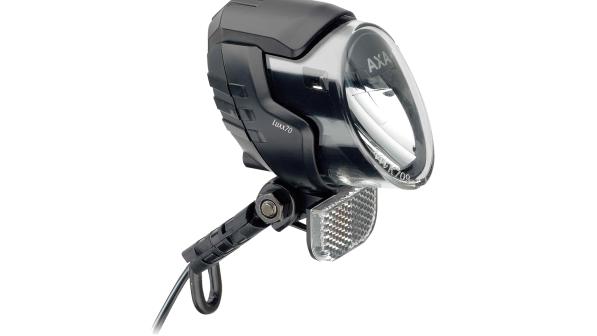Group test : front bike lights

Powerful, reliable and longer lasting, battery bicycle lights have come a long way in the last couple of decades. So bright are most of today’s LED front lights that some form of switched reduction in light output is a desirable feature, not just to save power and extend run time, but to allow the light to be dipped when used on unlit roads.
‘Dipped’ isn’t quite the right word; with the lights on test, there’s no change in beam direction or angle as the light switches to a dimmer mode. In any case, the light should be angled to avoid dazzling oncoming road users even on maximum power; this will have the further benefit of casting the beam on the road ahead.
Along with vastly increased run time from batteries speedily rechargeable through a USB port, the best of current bike lights are made to last, with sturdy exteriors and weather proofing. Even the lowest-powered light on test provided effective illumination on unlit back roads.
When cycling at night, you’re legally required to have approved white front and red rear lights, as well as a red rear reflector and amber pedal reflectors. To find out more about the law read our lighting regulations page.
1 Magicshine Eagle 600
Price: £64.99. Available from: Magicshine.

This feature-packed light may boast just 600 lumens on maximum power, but its well-focused central zone provides sufficient illumination, without a lot of spread, for brisk riding on unlit back roads. Side-mounted orange lenses aid visibility.
A display on the top gives remaining battery life and power setting (of four, plus flashing mode). The screw-tightened clamp is a neat but complex affair, with three straps provided to accommodate various handlebar diameters. A thumb lever operates the quick release, which has push-to-click installation.
The switch is more of a flat pad than a protruding button and requires a firm press. Supplied with USB charge cable only.
Run time: 1.5hr on max, 10hr on min.
Verdict: Impressive performance and intricate design.
2 Lezyne Macro Drive 1100XL
Price: £69.99. Available from: Lezyne.

Secured with a ladder-type rubber strap that requires a good tug to pull over a 31.8mm handlebar bulge, the Macro Drive 1100XL wallops out 1,100 lumens on the maximum ‘Overdrive’ setting and 650 in ‘Blast’.
Six outputs are available, including a pulse setting that ebbs and flows disconcertingly. There’s also a timesaving mode that switches between Overdrive and Economy only.
Although it feels weighty in the hand, it is only 155g. The protruding switch button is easily felt and requires little pressure to operate. The beam has a well-focused central zone with gently diffused surround and lateral cutaways let the lens shed light to the sides. Supplied with USB charge cable only.
Run time: 1.25hr on max, 16hr on min.
Verdict: Minimalist design meets maximalist performance.
3 Supernova Airstream 2
Price: £199. Available from: Amba Distribution.

Something of an outlier in this test, the 165g Airstream puts out a comparatively meagre 205 lumens and has no flashing mode. It is built to comply with German lighting regulations and has a distinctive, effective beam pattern that, to avoid dazzling other road users, sheds very little light above the centre.
It has a broad central patch and gives diffuse illumination of the foreground. Side illumination is provided by light shining through the lettering on the lens surround. The charge port is on the underside of the lens surround and is covered in use by a rubber cap which, lacking a strap connecting it to the light body, looks easily lost.
The top-mounted switch button is well defined and requires a fairly soft touch to operate. The light is secured effectively using a beefy rubber O-ring with moulded tongue that hooks over a machined aluminium bracket. The O-ring is perhaps a little too beefy, needing excessive effort to pull tightly enough to hook over the bracket.
Run time: 2.5hr on max, 14hr on min.
Verdict: Low powered but& effective and beautifully made.
4 Exposure Strada 800
Price: £236.20. Available from: Exposure Lights.

Built to Exposure’s usual high standard and weighing 185g, the Strada 800 belts out up to 800 lumens in one of four intensity settings, plus an off-beat ‘DayBright’ flashing or ‘pulse’ mode that is claimed to be visible from a kilometre distant.
The circular beam is mostly diffuse with a well-defined central zone; a lot of light is cast upwards, making use of the dimmer settings highly advisable where appropriate. Small cutaways in the lens periphery allow overspill to provide side lighting.
Sited on the back of the light, the switch button is easily felt with gloves. A small display gives remaining run time, backed up by green to red warning lights.
Run time: 3hr on max, 36hr on min.
Verdict: Expensive, but you get what you pay for.
First published in Cycle magazine, October/November 2017 issue. All information correct at time of publishing.
Cycle magazine
Every two months Cycling UK members receive Cycle magazine, filled with interesting and informative articles, news and reviews for all cyclists.
Members can read the magazine in full online; non-members can read selected highlights.







